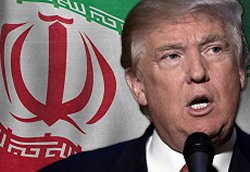
|
- Iran: Eight Prisoners Hanged on Drug Charges
- Daughter of late Iranian president jailed for ‘spreading lies’ - IRAN: Annual report on the death penalty 2016 - Taheri Facing the Death Penalty Again - Dedicated team seeking return of missing agent in Iran - Iran Arrests 2, Seizes Bibles During Catholic Crackdown
- Trump to welcome Netanyahu as Palestinians fear U.S. shift
- Details of Iran nuclear deal still secret as US-Tehran relations unravel - Will Trump's Next Iran Sanctions Target China's Banks? - Don’t ‘tear up’ the Iran deal. Let it fail on its own. - Iran Has Changed, But For The Worse - Iran nuclear deal ‘on life support,’ Priebus says
- Female Activist Criticizes Rouhani’s Failure to Protect Citizens
- Iran’s 1st female bodybuilder tells her story - Iranian lady becomes a Dollar Millionaire on Valentine’s Day - Two women arrested after being filmed riding motorbike in Iran - 43,000 Cases of Child Marriage in Iran - Woman Investigating Clinton Foundation Child Trafficking KILLED!
- Senior Senators, ex-US officials urge firm policy on Iran
- In backing Syria's Assad, Russia looks to outdo Iran - Six out of 10 People in France ‘Don’t Feel Safe Anywhere’ - The liberal narrative is in denial about Iran - Netanyahu urges Putin to block Iranian power corridor - Iran Poses ‘Greatest Long Term Threat’ To Mid-East Security |
Saturday 26 February 2011Iran’s Internet Restrictions
Demotix.com, Access to internet in Iran is limited. Websites Facebook and Twitter are blocked along with a number of international news sites such as the BBC. Images from inside a Tehran internet cafe. Tehran, Iran. Still, with knowledge and software, it is possible to get around the “great firwall of Iran”. But reports suggests that Iranian authorities have gradually become better at filtering the traffic. In the first few years of the 21st century, Iran experienced a great surge in Internet usage, and, with 20 million people on the Internet, currently has the second highest percentage of its population online in the Middle East, after Israel. When initially introduced, the Internet services provided by the government within Iran were comparatively open. Many users saw the Internet as an easy way to get around Iran’s strict press laws. A clampdown started with the election of Iranian president Mohammad Khatami, and the start of the 2nd of Khordad reform movement. It worsened with the administration of conservative president Mahmoud Ahmadinejad in 2005. Regime opponents in Iran are said to rely heavily on Web-based communication with the outside world. Many bloggers, online activists, and technical staff have faced jail terms, harassment and abuse. In November 2006, Iran was one of 13 countries labeled “enemies of the internet” by activist group Reporters Without Borders. In March 2010, it was one of twelve regimes so labeled. Following the 2009 Iranian presidential election, the U.S. Senate ratified a plan to help curb “censorship in the Islamic Republic”. The legislation dubbed the Victims of Iranian Censorship (VOICE) Act was allocated $50 million to fund measures “to counter Iranian government efforts to jam radio, satellite, and Internet-based transmissions.” Recently, the Iran government required all Iranians to register their web sites in Ministry of art and culture. They also plan to filter all other websites up to March 2007. |






